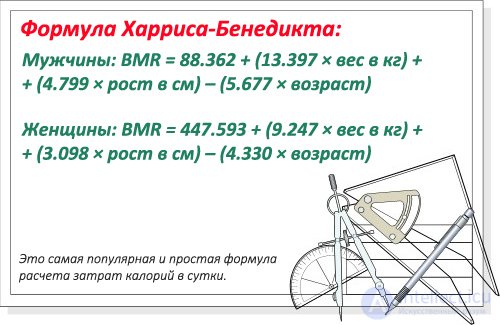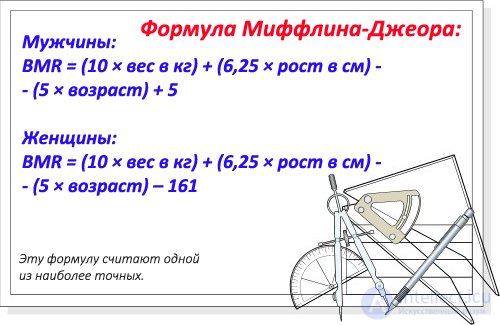Lecture
It is no secret that for weight loss it is necessary that the calorie expenditure was higher income. If the intake of calories depends only on the consumption of food and beverages, the expense is divided into basic and additional. Basic calorie consumption is the energy expenditure to support vital activity, and the additional one is the amount of energy that we spend on training and any other physical work. To avoid confusion in these terms, let's consider them in more detail.

The body spends much more calories on the maintenance of vital activity than on training activity. We do not notice this, but our body spends energy on breathing, metabolism of proteins, carbohydrates and fats, cognitive functions and support of the nervous system, heartbeat and other internal organs, to maintain hormonal levels, to sleep, to movement and, even, to food . The work of the body does not stop for a minute.
Basic calorie consumption shows the state of metabolism. You can calculate it by the following equations: Harris-Benedict, Mifflin-Geor, Katch-McArdle.

This is the most popular and simple formula for calculating the cost of calories per day. To do this, specify the height, weight and age. In 1984, it was revised to reflect updated medical requirements.
Actual version of the equation:
Males: BMR = 88.362 + (13.397 × weight in kg) + (4.799 × height in cm) - (5.677 × age)
Women: BMR = 447.593 + (9.247 × weight in kg) + (3.098 × height in cm) - (4.330 × age)

This formula was born in 1990. It is considered one of the most accurate. For the calculation it is also necessary to know the weight, height and age.
Males: BMR = (10 × weight in kg) + (6.25 × height in cm) - (5 × age) + 5
Women: BMR = (10 × weight in kg) + (6.25 × height in cm) - (5 × age) - 161

It is considered the most accurate, but it is calculated on the basis of dry body weight without taking into account fat, and for this you need to know your percentage of fat.
Calculation of dry body mass (LBM):
LBM = [weight (kg) × (100 -% fat)] / 100
Calculation of basic calorie consumption (BMR):
BMR = 370 + (21.6 × LBM)
Basic calorie consumption is associated with both the amount of fat and the amount of muscle mass. The more muscle you have, the more energy your body spends at rest.

Lack of calorie intake should never fall below baseline consumption. Otherwise, the body will begin to save energy due to hormonal levels. First, it will decrease the level of leptin (saturation hormone), then the hormones of the thyroid gland and the reproductive system. You must always have available energy to maintain the endocrine, nervous and other systems. A healthy diet, adequate deficiency and long-term weight loss will help avoid hormonal disturbances.

The additional energy consumption is divided into calories that we spend on training and calories spent on non-training activity.
In training, we spend relatively few calories - an average of 400 calories per hour of intense exercise. With three workouts per week, this gives us only 1200 calories. However, if workouts are aimed at strengthening muscle tissue, then the basic energy costs will increase. The body spends more calories on building and maintaining muscles than on storing and keeping fat.
Under non-training activity (NEAT) is meant any spontaneous or routine physical work: walking, shopping, cleaning, cooking, playing with a child, and even working at a computer.
You can calculate additional energy waste in the Calorie Consumption Analyzer. Suffice it to specify your weight, select the type of activity and mark the time in minutes. The system will count everything for you.

Knowing the energy costs makes it possible to correctly calculate the calorie deficit for weight loss, but it is rather difficult to predict the exact weight loss.
Difficulties may arise due to:

To avoid the above difficulties, eat properly within the calorie corridor and BJU, soberly assess your own training activity, trying to keep it at about the same level every day, exercise regularly, weigh and measure volumes at the same time, and also consider the phase of the menstrual cycle.
The question of his weight worries any man, and in particular - a woman. It is very important for her to know how much it weighs, and whether it does not exceed the generally accepted standard. In this case, the online calculator is very convenient, thanks to which you can see exactly how many calories per day by day of the week you need for quick or normal weight loss. If your weight is completely satisfied, it is useful to know how many calories are required so that it does not begin to change. Finally, it is just necessary to have an output on the calculator of daily calorie consumption, when a teenager, for example, is underweight, and parents are trying to find out exactly how many calories he needs every day.
Comments
To leave a comment
Human physiology, hygiene and age physiology
Terms: Human physiology, hygiene and age physiology